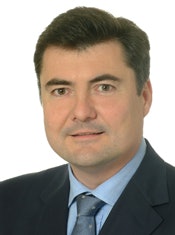
Radiology is one of the specialties most liable to claims based on medical malpractice, and radiologists do not get a second chance to amend an initial interpretation of an examination, according to an Austrian medicolegal expert.
"There seems to exist a serious 'infection' of patients with 'litigosis' due to the cash-back mentality of consumers," said Vienna-based lawyer Dr. Markus Ludvik. "Expect an increase of malpractice cases all over the world, especially for those patients with legal protection insurances."
 Expect an increase in malpractice cases, warns Dr. Markus Ludvik. Credit: Foto Fayer, Vienna.
Expect an increase in malpractice cases, warns Dr. Markus Ludvik. Credit: Foto Fayer, Vienna.Most complaints about radiologists' liability issues are based on failures of diagnosis, he noted. Radiological error is multifactorial, including failures due to poor technique, perception, lack of knowledge and misjudgments, errors in interpretation, and poor communication, as well as the failure to suggest the next appropriate procedure.
Despite most doctors being well-informed about the basics of medicolegal malpractice, he thinks there is still a need for professional programs to highlight the issues, and there seems to be a lack of information concerning the specifics. He considers this is partly due to the fact that radiology may not have kept pace with changes in this arena. Furthermore, due to the variety of new diagnostic systems, there are various scientific platforms and discussions targeting new approaches to this topic.
Ludvik, a speaker at today's Professional Challenges session, also thinks that this situation may have something to do with what he refers to as a "faint physician-patient relationship."
"When a radiologist receives an order or request from another physician to perform an imaging study or procedure on a patient, the radiologist becomes part of the patient's medical team," he explained. "However, the radiologist will frequently have no personal contact with 'their patient' at all, but this does not exempt them from legal obligations due to the requirements for comprehensive counseling and information."
ECR 2015 delegates learned how to increase their awareness and knowledge of malpractice risks in the era of "epidemic malpractice suits" and identify strategies that reduce and minimize the problems leading to malpractice litigation.
Ludvik provided tips and advice on how best to reduce the chances of legal action by expanding their medicolegal horizon. He urged radiologists to think like a patient, communicate with patients in a consistent manner, and take time to ensure that the patient fully understands the diagnosis and treatment. Various electronic programs supporting the recording of patient data are on the market, but their benefit strongly depends on accurate data administration and management, he added.
Ludvik also stressed the importance of scrupulous documentation by providing written instructions and appropriate documentation, which reflects the standard of care given. He recommends providing legible written and/or data-processed records, which should contain adequate identification of the patient, the condition and initial reason for seeking advice, diagnosis, treatment provided, insurance and billing details, Social Security number, and a documentation of allergies, including contrast agents and other medical complications. All patient records received from other healthcare providers should be included.
Only those terms and abbreviations common to all medical professionals should be used. Ludvik is also a keen advocate of the necessity to make a clear record of professional competence by continuously documenting all education and training received, and he urges radiologists to be properly insured against malpractice risks and legal expenses.
 Patients tend to think imaging will always give the answer and is infallible, according to Dr. Jane Adam.
Patients tend to think imaging will always give the answer and is infallible, according to Dr. Jane Adam.Despite such expert advice and strenuous warnings about the importance of good insurance and documentation, co-presenter Dr. Jane Adam makes a clear and simple point: "Nobody is perfect and things go wrong, however hard we try."
Adam, a consultant radiologist at St. George's Hospital in London, asks whether human error necessarily equates to substandard care and suggests that radiologists should try to identify the root cause of errors, learn from mistakes made, and design systems and working practices to minimize them and prevent repeat mistakes happening.
"Radiologists cannot always avoid error, unless we never commit ourselves to an opinion, in which case we are not doing our job," she emphasized.
Adam thinks that in the case of errors, a culture of openness and clarity -- as opposed to secrecy and evasion -- may help ameliorate the chances of ill feeling and possibly reduce the risk of a malpractice lawsuit. She also considers patients may have an unrealistic expectation about the accuracy of imaging, suggesting that a well-informed patient who understands the reality that imaging may not reveal what the clinician suspects, may be less likely to sue in the case of a misdiagnosis.
"Patients now tend to be under the impression that imaging will always give the answer and is infallible," she added.
Adam also considers the impact of error on the radiologist. She is clear that in the case of a misdiagnosis or misinterpretation of an image, invariably this will cause great distress for the radiologist. Other than informal peer support from colleagues, there is not much in the way of a formal support network for the radiologist who has made an error or is being accused of having done so, and the stress can have an immense impact.
Originally published in ECR Today on 6 March 2015.
Copyright © 2015 European Society of Radiology










